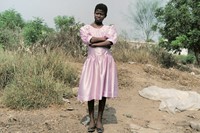In Shining Lights, the “first critical anthology to bring together the groundbreaking work of Black women photographers active in the UK during the 1980s and 1990s”, a constellation of rarely-seen stars finally take their rightful place in the sky. Published by Mack Books and Autograph – previously known as the Association of Black Photographers – and edited and researched by influential photographer Joy Gregory, assisted by art historian Dr Taous Dahmani, Shining Lights offers a fascinating deep-dive into a vital period of photographic history. Besides photographs, the book features roundtable conversations, ephemera, and essays.
The genesis of Shining Lights originates with a friendship. In 1986, after Gregory moved to London to enroll in a photography course at the Royal College of Art, she met Araba Mercer, a young woman who was studying to be a librarian. Soon enough, the two were “hanging out in each other’s homes, drinking gallons of tea”. Eventually, they came up with the idea to publish a book on Black women’s photography. “As Black women, our work as artists and photographers was considered to be unimportant and appealing only to a limited audience of ‘our own community’,” writes Gregory in the book’s introduction. This myopic view often excluded Black women photographers from museums and galleries. “Books and magazines were often the only ways photographers could share their work. By producing publications, we were able to show what we were doing within our community, and to show that we existed, that we understood and could write about our context, and that the work we were producing was hugely varied.”
Due to cost constraints, that book never came to fruition. When Autograph invited Gregory to speak during an occasion to celebrate photographer Maxine Walker in 2019, Gregory was prompted to reflect on “the context in which we had both developed a practice." “Maxine and I go back a really long time,” says Gregory. The two both worked at the North Paddington Community Art Room in the mid-80s and Walker helped Gregory secure her first job in the arts. Despite Walker’s significance – she created seminal self-portraits in her Untitled (1987) and Black Beauty (1991) series – Walker never got her due. “She had an accident in the early 90s and it really knocked her confidence,” explains Gregory. Walker was never the same again. “It was a really big thing for her to have an exhibition because she really was one of the pioneers of that time in terms of practice.” Like her peers Carrie Mae Weems and Deborah Willis, Walker laid the groundwork for an entire generation of Black women photographers.
As Gregory prepared for the talk, she found plenty of ephemera – leaflets, “DIY stuff” – but had difficulty sourcing images of Walker’s contemporaries. Walker is just one in a generation of Black women whose contributions to the practice of photography have been criminally forgotten, neglected, or ignored. Much of this has to do with a lack of preservation. Gregory cites Liz Ward, a librarian at Chelsea College of Arts, as an important archivist who started collecting material in the 80s. Gregory visited Chelsea in her search to generate material for what would eventually become Shining Lights. She went to the archives of Iniva, Goldsmiths, and Autograph as well. “There’s a lot of invisible work that goes on with doing a project like this,” says Gregory. “You have to take into account [that] not a lot of people are actually on the internet. They’re very suspicious of it. We’re dealing with a level of communication where people will happily write a letter or go on the phone.” Gregory took the old-fashioned, more personal approach, making house calls and even organising a tea party. “I went under a number of beds,” she says.

Some found revisiting the period in which they made the work traumatic. “Some people had quite chaotic lives,” Gregory explains. “It was quite hard for people to make any sort of living, particularly once various institutions started to have cuts or disappeared. People’s income went and they had to think quite differently about how they would make their way in the world.”
Shining Lights excavates the photographic practices and spaces outside “the white cube gallery” that allowed these artists to flourish. In the book’s roundtables, artists cite Camerawork, Photo Co-op, and Monocrone as a few locales that were crucial to their development. “People would be in their late twenties, thirties, and forties. They’d be thinking they’d be having families or did have families that needed to be supported,” says Gregory. “The dream of being a photographer is one that is very privileged. It was a very privileged moment at that particular time because the materials were quite expensive. Access was expensive and difficult, universities were not like they are now. To go to art school was a huge thing. And you’d need quite a lot of encouragement from your family,” Gregory elaborates.
“The book is just a starter. It’s the sharp end of the wedge, because there’s so much more to be said” – Joy Gregory
DIY, community-driven spaces and grassroots organisations were essential. “We’d support each other through these networks,” says Gregory. The diversity of backgrounds and experiences meant that there would be “huge discussions” and disagreements, but there was a general sense of coalition that came from a shared political position. “Blackness at that particular time in the UK was very different from the American version or even the British idea of Black today,” says Gregory. In the words of Paul Gilroy – whose writings shaped how many of these Black women thought about and approached their artistic practice – Blackness was not “a phenotype or a physical description” but instead an identity “collectively assembled in adverse circumstances and conditioned by the effects of systematic racism.” Shining Lights reveals the ways in which these women embodied intersectionality before the phrase came to be.
Shining Lights’s design reflects a deep care for not just the photographic material, but also the actual people who created them. In the table of contents, the books’ themes are highlighted in orange, a specific request of Gregory’s. “A lot of the women that worked in photography and a lot of my students in photography are really dyslexic or dyspraxic and they have some sort of difficulty with seeing lots of text,” Gregory says. As a text, it is extremely comprehensive. The work within is broken down according to ten themes, ranging from ‘Together: Community and Activism’ to ‘Exploring Process and Materiality’, and features multiple roundtables as well as portfolios from Carole Wright, Mitra Tabrizian, and Cristina Piza. One design element that couldn’t be included were biographies for each photographer. “As a young person, I’d find that really interesting, to think of somebody whose main practice was doing one thing to actually be doing something completely different 20, 30 years later,” says Gregory. Although the professions range – from psychotherapy to nursing to running an allotment – ”they’re very people-based,” she says.

Despite the efforts of Gregory and countless others, the archive still contains gaps. “I still work at the University of the Arts, London, which means I have access to all of the libraries. I worked at the London College of Printing, now the London College of Communication. I did that for ten years, from 1998 to 2008,” Gregory says. “Having access to that and not being able to find any material also drove me on to think about how you tell that story so it includes everything, [or] as much of that space as possible.” Despite the celebration and joy found in Shining Lights, there’s an underlying sense of grief, a knowledge that among the many images found are hundreds lost. “One of my biggest regrets is not being able to find Rhona Harriette. I asked every person who was alive if they knew where she was. She’s so completely hidden from sight.”
The enthusiasm around the book’s release, however, is reassuring. Tickets for the launch, which takes place February 22, sold out within a few hours. Gregory hopes there will be an exhibition to coincide with the book’s publication. “The book is just a starter,” she says. “It’s the sharp end of the wedge, because there’s so much more to be said.”
Shining Lights: Black Women Photographers in 1980s–90s Britain, edited by Joy Gregory, is published by Mack, and is out now.






